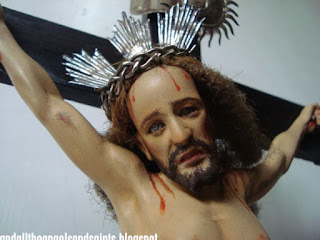About five months ago, this Niño was circulated by a dealer via SMS to collectors and prospective buyers. It was passed on to me by a colleague who said that it was available for Php25,000.
One look and I was instantly turned off by the sorry state of this image carved in softwood. The Holy Child, which looked very old, seemed to have caught a bad case of vitiligo—it had peeling encarna all over his face and body.
To make matters worse, it had broken toes and fingers, and its glass eyes were blackened with age, giving it a look not unlike a creature with a ghostly stare.
It was pretty obvious that there was also something totally wrong with the way it stood on a pointed wooden perch that was affixed to another circular base.
Clearly, the base was not original to the piece—and upon closer examination, I saw that the foot of the Niño was just screwed onto the perch, which suspiciously looked like an old architectural detail salvaged from some antique house.
But I sensed something special in the Niño itself, barring its major imperfections. For one, it was classically carved, well-proportioned and, at 12 inches, was of very good size.
The standing Niño shows his two uplifted hands, with the left hand in a palm-up position. The right arm, which is traditionally raised in the act of benediction, curiously shows a set of hands turned inwards, in a grasping position, which indicates that the image may have held a staff or a rod at some time (or maybe an orb?)
It was also an authentic antique, perhaps a century-old, based on its patina. At the back, there was a paper label that was glued on the carved piece, indicating that, at one time, it was part of a Manila antique shop inventory. Cagayan was listed as the image's provenance, and that it was from the 18th century.
Apparently, after peddling the image for several months, the Seller found no Buyer. It was then that I received another phone notification from a friend who had originally seen the Nino's photo, informing me of another cut price--this time, to more than half! My friend acted as a middleman, and in no time at all--I had the piece delivered to his office. The Nino was mine!
Soon as I brought the image home, I removed it from its perch and discarded the base, which was not old, after all. Left with just the damaged image, I came to a decision to have it re-painted and completely restored. Some collector-purists would disagree with me on this—preferring to keep the image in its original state to preserve the integrity of its antiquity, but I was not interested in creating a museum piece.
As has been the case, off I went to see Dr. Raffy Lopez to consult him on this project. I had several ideas about the Niño’s restoration, inspired by some images in the Santo Niño book of Ben Farrales.
In the end, I decided on a “cushion base” for my Christ Child (made by Celso Mataya), adapted from my preferred peg featured in the book.
Raffy and I agreed on an appropriate color for its encarna—something close to the complexion of Spanish/ Mexican colonial pieces that are characterized by a rosy blush. His painter, Edgar, new to the santo scene, did the paintwork and this was how it looked with the first paint layer:
Its broken fingers and toes had earlier been repaired by Bong Lauderis, Raffy's resident carver. When the Nino was staged on its new base, it looked something like this:
I felt that the potencias (by Dodong Azares) were way too big for the Niño head, and Raffy agreed to change them. And there was still something spooky about the eyes, so those were eventually changed too.
A few more days, and the Nino--standing 16.5 inches tall on its new base-- with its replaced potencias, new eyes and eyelashes—plus a free gold thread embroidered tapiz, courtesy of Raffy Lopez was ready to be picked up.
All it needs is a staff and an orb, which my metalsmith from Mexico will create. Maybe a new open crown and a longer wig will be made for my newest santo, but in the meanwhile, I am just happy with the thought that the Santo Nino that nobody wanted had finally found a home!













































